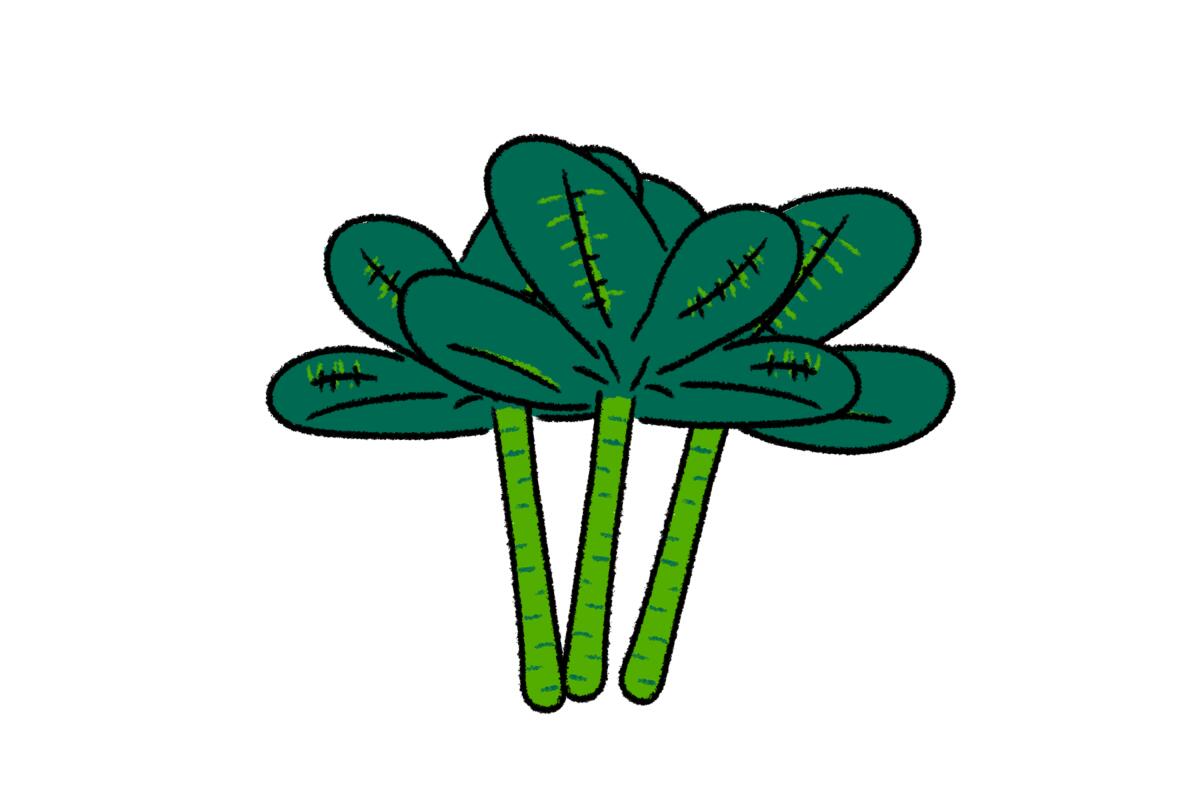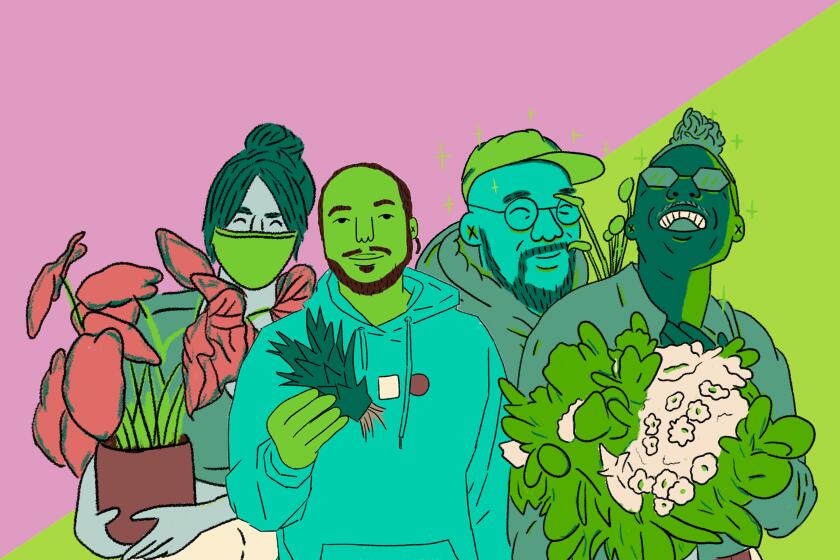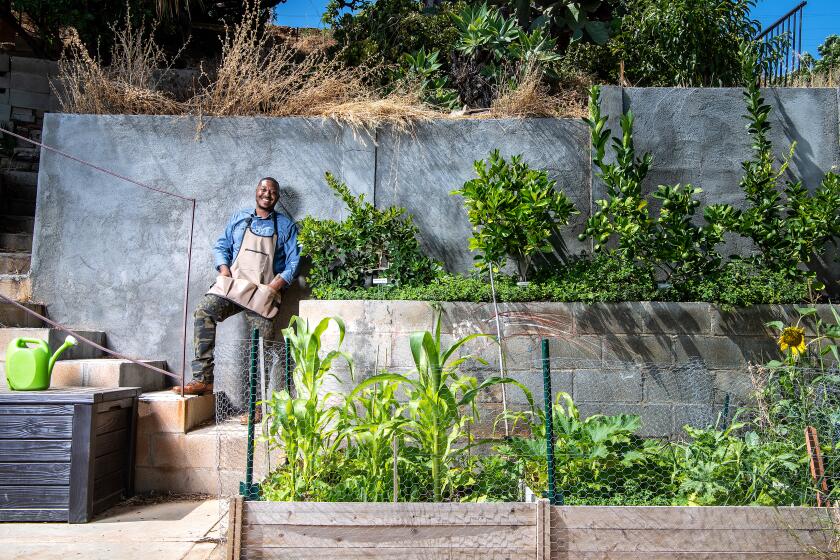This urban farmer transformed her lawn with collards, amaranth and sweet potatoes
- Share via
This is the latest in a series we call Plant PPL, where we interview people of color in the plant world. If you have any suggestions for PPL to include in our series, tag us on Instagram @latimesplants.
It’s an unlikely location for a farm: the front yard of a shared rental property in a residential neighborhood in the San Fernando Valley. But, Siri Lorece Hirth says, her neighbors often stop to admire her 1-year-old edible garden and visit the free farmstand she and her husband, Patrick, host on Sundays.
“Only a small portion of land is available for us to grow anything, but we have found a way,” says Hirth of her former front lawn.
Hirth has been gardening and growing food for years and founded her farm business — Creative Arts Farm — in 2015. “We were looking for land to expand, and we had a business plan,” she says. “When the pandemic hit, we thought about what we could do to help our community thrive during such a difficult time. I was doing garden consultations and thought, ‘Now is the time to offer wellness in a public way.’ I’m a business person. If I say I’m doing something, I’ll do it. And I’m so glad we did.”
In our Plant PPL series, we interview people of color in the plant world, including plantfluencers, plant stylists, floral artists, enthusiasts, experts and garden store owners.
Indeed, Hirth’s business model has taken off. She offers virtual garden consultations and restorative yoga classes and sells her tree collards at the Prosperity Market, a Los Angeles-based mobile farmers market that hosts Black farmers. (While she documents her growing journey on Instagram @creativeartsfarm, she doesn’t share her home location publicly because she doesn’t want to encourage visitors who might disturb her neighbors.)
In a recent Q&A, the urban farmer, 40, weighed in on plant matters with encouragement and inspiration.
Tell us about your background in farming.
I grew up in a farming community in Iowa. As a Black female, there was not a lot of education about farming available to me. I started my first garden in Chicago, where my sustainability journey began. I was recycling and mindful of water waste, but it wasn’t until about 10 years ago that my mind-set changed on why and how you grow food and what that wellness looks like. It was a huge “aha!” moment: The nexus of all wellness comes from the earth. I love growing food. And I love plants. The first time a seed thrives and it gives you sustenance you can see the humanity in every single thing. I started gardening and spending more time with plants and examined how I interact with living beings. Being true to your purpose and finding out who you are is key to wellness. I have a lot of skills that I was born with, but music is a part of every part of my being. Nourishment and movement are another part of my being. What can I offer humanity? Food, movement and music. That is how Creative Arts Farm was born: Me offering myself as I am and the things that have brought me wellness that I would love to share.
Your homestead is a tiny house?
There is a main house on a half-acre lot and it has two RV stalls. We rent the tiny house and are off grid. The way we found it was crazy. We had decided that we wanted to go tiny, so we hopped on to a tiny house Facebook forum and asked if anyone knew of any tiny houses for rent. Buying one didn’t make sense to us. We initially found the lot as a place to put the tiny house. A year later, we were still looking for a tiny house to rent or build our own. We looked at the spot again and this time it had a tiny house available for rent! Apparently, it wasn’t working for the people who were living in it. I was able to negotiate a rental agreement with the tenant and I negotiated a land agreement with the property owner. I did this in five days. I will tell you, it has been quite an experience. It’s not hard to live tiny. I don’t know if we could live larger anymore. We are passionate about sustainability.
How did your front yard farm originate?
[My husband, Patrick, and I] were living here for about six months and were growing food in beds, grow towers and raised beds. We were unsure if we wanted to ask to use the front yard because we weren’t sure if we were going to stay. That was prior to the pandemic. We thought, “We have this opportunity, we have this space, we should do this.” We were determined to use the space strictly for seed cultivation. We wanted to get our food supply together. Everything we grow is from seed. I have a huge seed case that is just like photo storage boxes, and they are all labeled when they were cultivated. This is the easiest, least expensive and organized way to save seeds.
So we decided to expand to the front yard. Everything went well and went in fast. On a large scale, Black Indigenous people of color have not had land accessibility that has allowed people to thrive. It starts small. It’s not just USDA and farming corporations. It starts at home with home cultivation partnerships.
How did you take out the lawn?
Everything was done by hand. We used tarps and sticks. We measured and used string and created rows that are about 5 by 4 foot. We got our hand trowels and edgers, and we edged it out and then pulled out the grass and composted the soil that was not too weedy. We have clay soil, and it’s heavy and there is not a lot of life fortitude to it. We dug down about 17 inches with our shovels and removed all of the soil. Then we went to Lopez Canyon landfill, where they give out free topsoil and mulch, and we got several big tarp-loads of that. We mixed it into the clay and refilled every single row. It was an unbelievable amount of work. In the end, I won an Instagram contest for a sustainable rototiller. We didn’t want to do that. But we use it for compost amending. We knew it would be a lot of work, but it helped us prepare for what was to come.
Sometimes wellness is in the simple stuff. It’s a good lesson for me too.
What are you growing?
Everything is grown for multiuse. If it only has one use, we are not growing it. The flowers are edible and medicinal. Our main crops are sweet potatoes, tree collards and amaranth. Those are the things we offer to our communities. We also grow calendula, lavender, sweet alyssum, nine varieties of chile peppers, tomatoes, beans, black-eyed peas, corn, squash and pumpkins. Our goal is full sustainability. We consider ourselves urban homesteaders. We do a lot of dehydration at home. I ask my neighbors what they like because I will grow it. I grew a whole row of tomatillos for my neighbor. It was my first full harvest that I have been able to give to someone else. I got a sample of her tomatillo salsa in return. That was so wonderful. I want to support others’ wellness in ways that feel good.

Your favorite plant?
Tree collards. If I’m growing something, it’s because it’s special and I have a relationship with the plant. Everything is very personal here, and I believe in understanding the Indigenous history of where food comes from and how it contributes to how we interact with one another. Tree collards are a unique variety of collards. Most collards are annuals, but tree collards can live 10-12 years. They grow super tall and have branches that can grow out 10 feet wide. Each of those can be chopped off, stuck in the ground and propagated. It’s versatile, resilient, a champ in the heat and can tolerate neglect. It’s the plant that never stops giving.
Since you’re a singer, I have to ask: Do you sing to your plants?
I sing to my plants when I’m watering, when I’m sowing my seeds. I sing to the birds. My neighbors probably think I’m some crazy Snow White. It’s just the way I communicate.
Let’s talk about the drought. How do you address water shortages?
It’s intense. We reserve the grey water from our tiny house, so we utilize anything that comes from our sink as often as possible. We make sure we grow plants that don’t require much water or just need deep water and then we mulch. What’s key is how we layer our plants. We are dependent on permaculture growing methods, meaning how nature grows on its own. Our plants are stacked. Our front yard is sloped just enough to manage water. We lean heavily on the “three sisters” gardening technique, meaning we plant corn, beans and squash. The beans add nitrogen to the soil, and the pumpkins provide natural shade so we don’t have to water as often. We also have a lot of DIY gravity drip systems. We have a mini tower system with grey water for our raised beds — herbs — and that gives them a consistent drip of water without using tap water. We also use shade cloths when necessary.
So your goal is to find land for a farm?
In our land search, we are learning that we are most likely going to have to leave L.A. It tugs at my heartstrings. There’s a very special pocket of Black wellness providers who are committed to providing to the community here.
His East L.A. backyard is mostly concrete, but Ken Sparks has transformed the hardscape into something alive, with chickens, a butterfly garden and organic vegetables.
Do you have any tips for people trying to get started growing their own food?
No. 1 tip for good growing: Grow what you like to eat. Period. I was told, “Don’t grow peppers; they’re hard to germinate.” Don’t do that. When you’re committed, you’re going to spend the time figuring out how to grow what you love. I call it your plant love language. I have killed so many things. I don’t jibe with every plant. I’m not going to worry about eggplants. Really focus on what you like to eat and start with that. I started with tomatoes and microgreens. The greens germinate really fast, so it’s gratifying. That let me know that I like things that grow really fast. Microgreens are always in rotation. Tomatoes take a long time. So I balance slow-growing things with fast-growing.
How do you share your produce?
We have a free neighborhood farm stand. We grow extras to offer to our immediate neighborhood. We built a pink farm stand and put it out every Sunday, and the neighbors come by. It’s very much a take something, leave something. We end up with a ton of citrus from the neighborhood. It’s so heartwarming. I also offer collard varieties and seedlings at the Prosperity Market. They host exclusively Black growers, Black farmers, you name it —anything you find at your average farmers market. It is next level and such a special experience. There are virtual, in-person and produce box options.
Anything I forgot to ask?
If anyone has an acre of land with water utilities, please let me know.
More to Read
Sign up for The Wild
We’ll help you find the best places to hike, bike and run, as well as the perfect silent spots for meditation and yoga.
You may occasionally receive promotional content from the Los Angeles Times.













